
Picking a toilet for your camper van can be an intimidating experience.
There really are just… so many different kinds, from composting to chemical to incinerating. Lately, I've been testing the OGO Composting Toilet, a brand-new entry in the off-grid toilet arena. A lot of toilets used in camper vans were originally designed for boats and RVs, but the OGO toilet was designed with camper vans specifically in mind.
But first, the answer to the question that is undoubtedly on your mind: Did I poop in the OGO toilet for this review? Yes, reader, I did. Never before have I defecated for the purposes of evaluating a consumer product, but now that I've crossed the Rubicon, I am a changed man. And my van will never be the same, either. Before, it was a vehicle that had never known the influence of human waste, but now that innocence, too, has been lost…
Input may receive a portion of sales if you purchase a product through a link in this article. We only include products that have been independently selected by Input's editorial team.

What is it?
The OGO is a composting toilet with a urine diverter. In simple terms, this means that solids go into a chamber filled with a composting substrate like coco coir, and the urine goes into a big (albeit well-designed) bottle. Both are emptied by you at appropriate dumping stations, meaning that you will, in fact, have to deal with your waste.
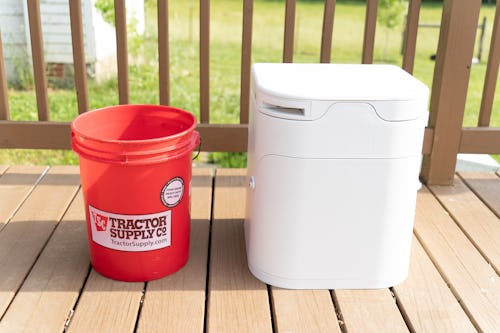
The whole category of “composting toilets” is a delightful misnomer that elides our shameful attitude towards poop in general. Most composting toilets only have room for about two weeks of occasional pooping, but two weeks isn’t even close to enough time to actually compost anything. So really, all composting toilets are more akin to a litterbox for humans.
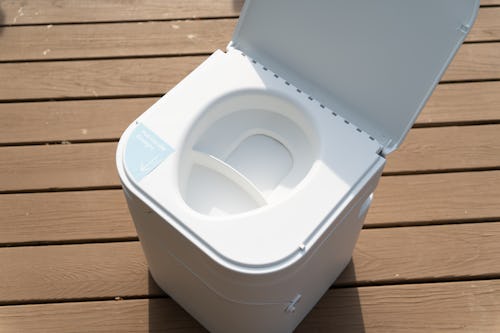
Just like a litterbox, the function of a composting toilet is to dry out your poop as quickly as possible, as this eliminates most of the smell. Some composting toilets also have agitators, which break up and mix the solids into the composting substrate, further speeding the drying process.
To eliminate the rest of the odor, many composting toilets will use a small fan and a vent hose that leads outside. Just to be clear, you don’t have to vent in your build, but you probably should.
Compact design
To understand the design of the OGO, you have to look at it in the context of the competition. Two of the big commercially available options are the Nature’s Head and Air Head toilets. Then there’s the more bespoke C-Head toilet, which many vanlife people choose because of its simplicity and lower price. I don’t know what the connection to “head” is with all these toilets, and at this point I’m too afraid to ask.
It has great butt-feel.
This is hard to convey if you’ve never built a camper van or a tiny home before, but designing something for use in small spaces is really hard. In my van, for example, I decided to drop the shower and replace it with a bench filled with batteries. Good idea, but now the drawers in the cabinet across from it can’t be removed (because they don’t pull out far enough).
There are so many things like this to consider when building a van, but the OGO does (mercifully) make it easier by virtue of being really small. The toilet’s footprint is 16 inches wide x 15 inches deep, and just for comparison’s sake, the C-Head is 15.25 x 20 inches and the Nature’s Head is 21 x 19 inches.
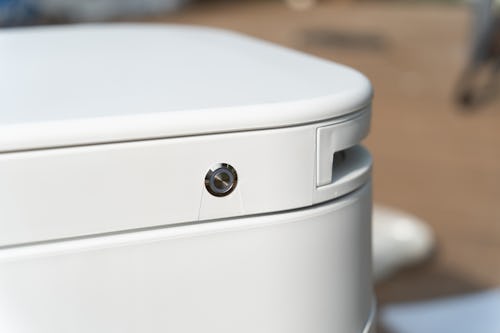
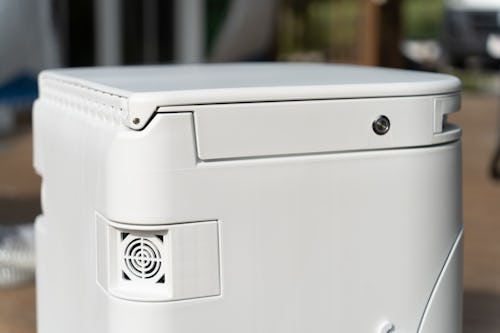
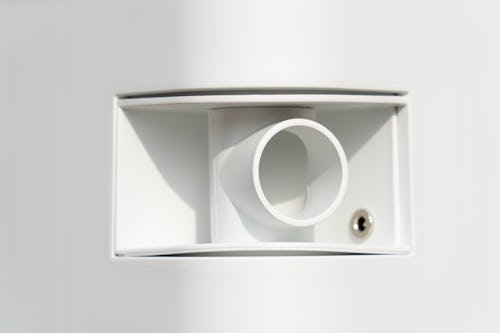
Kevin Barchlett, the lead designer and chief operating officer at OGO, really wanted me to know how much effort went into minimizing the footprint of the toilet while maximizing internal volume (to hold more waste), all while keeping all the inside bits accessible and ergonomically… possible, in cramped spaces.
“I don't know how many hours and hours I had tearing my hair out to try and keep this small profile,” says Barchlett. “It would have been a lot easier to go even an inch or half-inch wider. There were so many situations where I had to remake the bowl design, drain pan design, having to open and change that model again because you had to hinge it up so that you could access everything. So given that we were able to have everything in this small compact space, where we chopped off four to five inches compared to some of our competitors, that speaks volumes in the tiny house world and the vanlife world. Everything is space-oriented.”
Using the toilet
When I first pulled the OGO out of the box, I sincerely wondered how comfortable it could really be, given its tiny size. However, I got the toilet bolted down and sat on the top with the lid closed and found that it actually supports most of my butt. At around 18 inches tall, it's just a little shorter than I wanted it to be, but if the OGO were built into a cabinet with some half-inch plywood underneath, it’d be perfect.
The solids chamber is sealed with a sliding door, so when you go to use the toilet you need to lift the lid, open the solids door, and then sit down. The seat is about the same size as an airplane seat (though I have no idea what goes on in first class), and is made of a nice injection-molded plastic with a very soft matte finish. It has great butt-feel.
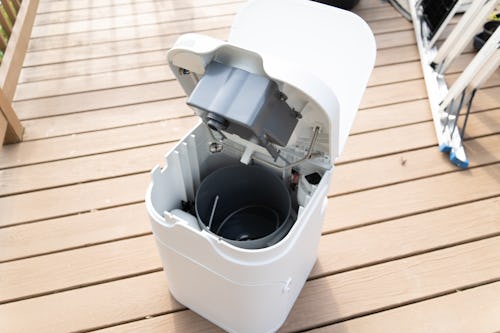
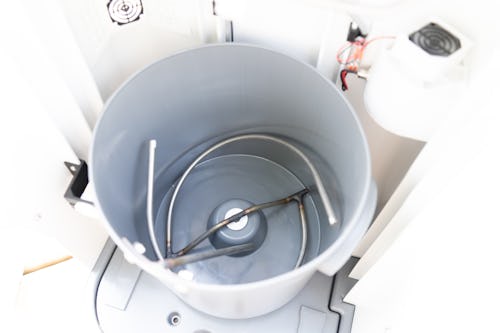
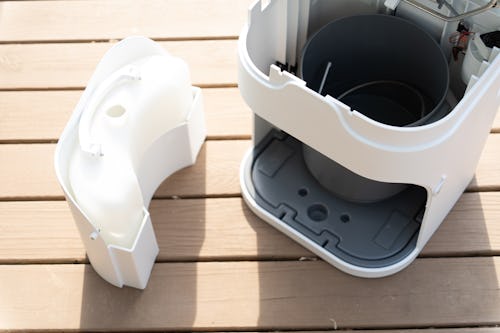
The urine diverter in the OGO seems very well designed, and though I can’t say this for sure, it seems like it is made so that people with internal genitalia can use it properly. It also has enough space for you to easily clean and sanitize.
Once you’re done, you push the solids lever back in, and the chamber seals back up. Then you push the button on the side and the agitator starts to spin. As far as I know, OGO is the only composting toilet that has a fully electric agitator. You need to crank the C-Head and you need to spin the wheel on the site of the Nature’s Head toilet. Not so with the OGO.
As handy as the electric agitator is, it requires electricity. There is no manual override for situations where the power is out. I imagine for most bougie van builds this won’t be a problem, but for the true vanlife minimalists out there, it’s something to consider.
The waste
Here we are, the most important part of owning a composting toilet: emptying the waste. Because of the toilet’s small size, there’s a bit of a procedure for gaining access to the inside. You first need to pop the lid a bit, then unhook the latches in the front and tip the front access panel forward and out. This panel houses the liquid waste bottle, so if you just need to empty that, this is all there is to it.
To empty the solids bin, you have to do the procedure above to remove the front panel and liquid waste bottle, then shimmy the solids bucket out through the front. When designing your van, make sure to leave room in the front and above the toilet for waste removal.
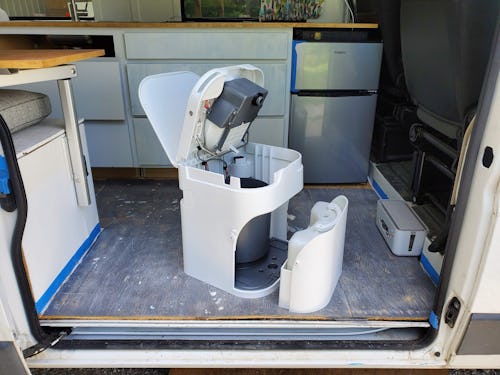
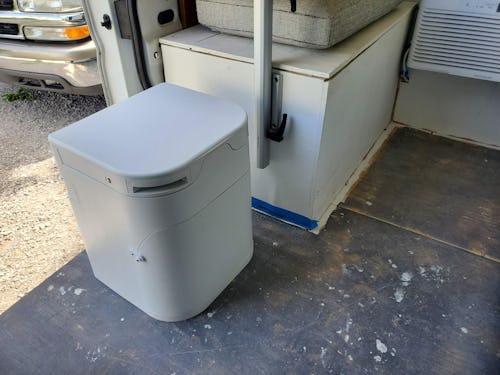
Provided that you used the toilet correctly, the solid waste container should contain dry, loose solids that are easy to dump into a bag and dispose of in a garbage can (or whatever legal waste management avenue you have access to). If it’s not dry and crumbly, you might want to mix in a little fresh coco coir to absorb the moisture (which is also why you should always leave a little room in the solids container). After emptying, you’ll want to get everything as clean as possible before putting the solids container back into the toilet.
Royal crapper
Compared to other composting toilets, the OGO is a somewhat premium option at $1,185. The C-Head and Nature’s Head cost $825 and $995, respectively, and that $200-400 difference is not nothing.
But here’s what the OGO has going for it: It’s one of the very few composting toilets with a fully electric agitator, and it has a really thoughtful design that makes it easy to integrate into basically any off-grid application, but particularly camper vans because of its small size.
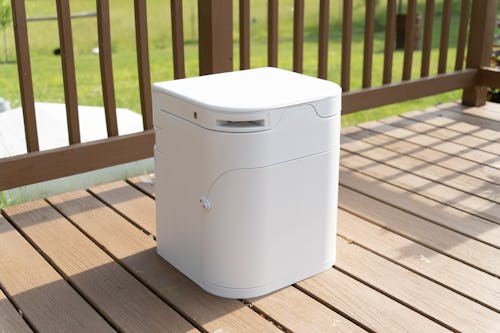
The ideal toilet provides the illusion that human waste isn’t a thing and doesn’t exist, and OGO provides as much of that illusion as can reasonably be expected in a moving vehicle.







